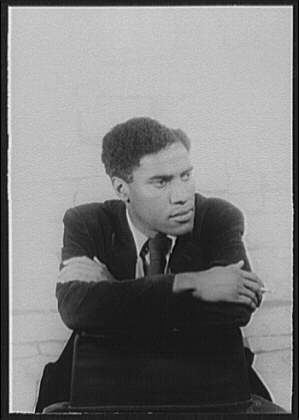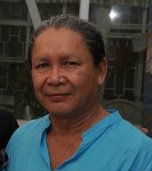Guyanese literature covers works including novels, poetry, plays and others written by people born or strongly-affiliated with Guyana. Formerly British Guiana, British language and style has an enduring impact on the writings from Guyana, which are done in English language and utilizing Guyanese Creole. Emigration has contributed to a large body of work relating the Guyanese diaspora experience.
Martin Wylde Carter was a Guyanese poet and political activist. Widely regarded as the greatest Guyanese poet, and one of the most important poets of the Caribbean region, Carter is best known for his poems of protest, resistance and revolution. He played an active role in Guyanese politics, particularly in the years leading up Independence in 1966 and those immediately following. He was famously imprisoned by the British government in Guyana in October 1953 under allegations of "spreading dissension", and again in June 1954 for taking part in a People's Progressive Party (PPP) procession. Shortly after being released from prison the first time, he published his best-known poetry collection, Poems of Resistance from British Guiana (1954).
Roy Aubrey Kelvin Heath was a Guyanese writer who settled in the UK, where he lived for five decades, working as a schoolteacher as well as writing. His 1978 novel The Murderer won the Guardian Fiction Prize. He went on to become more noted for his "Georgetown Trilogy" of novels, consisting of From the Heat of the Day (1979), One Generation (1980), and Genetha (1981), which were also published in an omnibus volume as The Armstrong Trilogy, 1994. Heath said that his writing was "intended to be a dramatic chronicle of twentieth-century Guyana". His work has been described as "marked by comprehensive social observation, penetrating psychological analysis, and vigorous, picaresque action."
Sir Theodore Wilson Harris was a Guyanese writer. He initially wrote poetry, but subsequently became a novelist and essayist. His writing style is often said to be abstract and densely metaphorical, and his subject matter wide-ranging. Harris is considered one of the most original and innovative voices in postwar literature in English.
Pauline Melville FRSL is an English-Guyanese born writer and former actor of mixed European and Amerindian ancestry, who is currently based in London, England. Among awards she has received for her writing – which encompasses short stories, novels and essays – are the Commonwealth Writers' Prize, the Guardian Fiction Prize, the Whitbread First Novel Award, and the Guyana Prize for Literature. Salman Rushdie has said: "I believe her to be one of the few genuinely original writers to emerge in recent years."
Arthur James Seymour, or A. J. Seymour, was a Guyanese poet, essayist, memoirist, and founding editor of the literary journal Kyk-Over-Al.
Kyk-Over-Al is a literary magazine published in Guyana, and is one of the three pioneering literary magazines founded in the 1940s that helped define postwar West Indian literature. Kyk-Over-Al is indelibly associated with the Guyanese poet and editor A. J. Seymour, the magazine's longtime editor. After Seymour's death in 1989 the editorship was assumed by poet and novelist Ian McDonald.
Jan Rynveld Carew was a Guyana-born novelist, playwright, poet and educator, who lived at various times in The Netherlands, Mexico, England, France, Spain, Ghana, Jamaica, Canada and the United States.
Edgar Austin Mittelholzer was a Guyanese novelist, the earliest novelist from the West Indian region to establish himself in Europe and gain a significant European readership. Mittelholzer, who earned his living almost exclusively by writing fiction, is considered the first professional novelist to come out of the English-speaking Caribbean. His novels include characters and situations from a variety of places within the Caribbean, and range in time from the early period of European settlement to the 20th century. They feature a cross-section of ethnic groups and social classes, dealing with subjects of historical, political, psychological, and moral interest. Mittelholzer is "certainly the most prolific novelist to be produced by the Caribbean". Mittelholzer committed suicide in England in 1965.
Peter "Lauchmonen" Kempadoo was a writer and broadcaster from Guyana. He also worked as a development worker in the Caribbean, Africa and Asia. He moved in 1953 to the UK, where he built a career in print journalism as well as radio and television broadcasting, and published two novels, Guiana Boy in 1960 — the first novel by a Guyanese of Indian descent — and Old Thom's Harvest in 1965, before returning to Guyana in 1970. He died in London, aged 92.
Michael Arthur Gilkes was a Caribbean literary critic, dramatist, poet, filmmaker and university lecturer. He was involved in theatre for more than 40 years, as a director, actor and playwright, winning the Guyana Prize for Drama in 1992 and 2006, as well as the Guyana Prize for Best Book of Poetry in 2002. He was also respected for his insight into and writings on the work of Wilson Harris.

George William Lamming OCC was a Barbadian novelist, essayist, and poet. He first won critical acclaim for In the Castle of My Skin, his 1953 debut novel. He also held academic posts, including as a distinguished visiting professor at Duke University and a visiting professor in the Africana Studies Department of Brown University, and lectured extensively worldwide.
Elly Niland is a Guyanese-born poet, playwright and teacher.

Caribbean Voices was a radio programme broadcast by the BBC World Service from Bush House in London, England, between 1943 and 1958. It is considered "the programme in which West Indian literary talents first found their voice, in the early 1950s." Caribbean Voices nurtured many writers who went on to wider acclaim, including Samuel Selvon, Edward Kamau Brathwaite, V. S. Naipaul, Derek Walcott, John Figueroa, Andrew Salkey, Michael Anthony, Edgar Mittelholzer, Sylvia Wynter, and others.

George Simon was a Guyanese Lokono Arawak artist and archaeologist. He was the founder and mentor of the Lokono Artists Group, a group of Lokono artists from Guyana, based primarily in Simon's hometown of St. Cuthbert's Mission. Simon was widely regarded as one of the leading Guyanese artists of his generation, and his paintings are notable for their explorations of Amerindian culture and the Guyanese environment. He was also recognized for his achievements as an educator, his efforts to develop opportunities for Amerindian artists in Guyana, and for his work as an archaeologist.
Angus Percy Bain Richmond was a Guyanese writer who spent most of his life in Britain.

Bertram Israel Augustus Charles was an influential Caribbean playwright who, with the theatre company he founded, Related Arts Group, wrote and produced plays in Georgetown, Guyana. Between 1963 and 1971 he produced sixteen one act and full-length plays at The Theatre Guild of Guyana Playhouse, including The End of the Affair (1968), The Alexin of Our Cure (1969) and Within Our Narrow Walls (1971). Today, in print, there are five Bertram Charles plays in 10 publications held by 42 libraries around the world, including The Library of Congress, Washington, D.C., The British Library and the University of Toronto.
Egbert Martin, writing under the alias Leo, was a 19th-century Guyanese poet.

The Bone Readers is a 2016 novel by Grenadan British author Jacob Ross, the second in his "Camaho Quartet." In 2017, it won the inaugural Jhalak Prize. In 2022, The Bone Readers was included on the "Big Jubilee Read" list of 70 books by Commonwealth authors, selected to celebrate the Platinum Jubilee of Elizabeth II.





